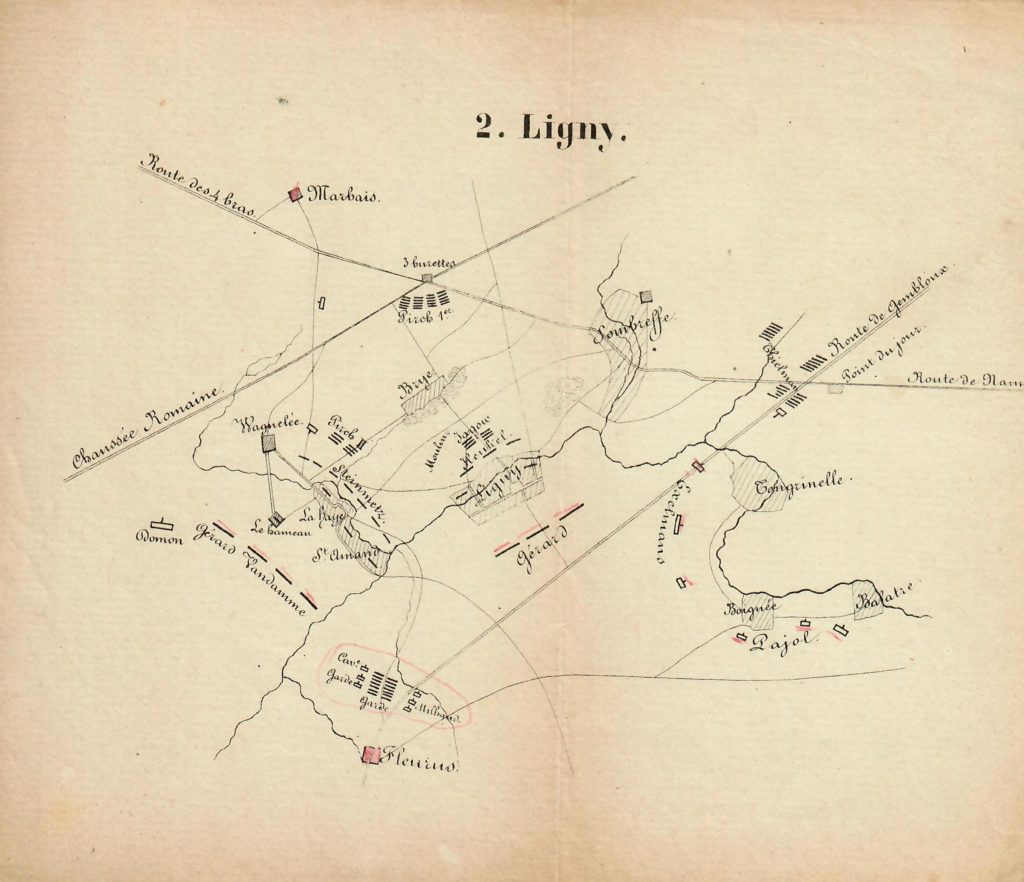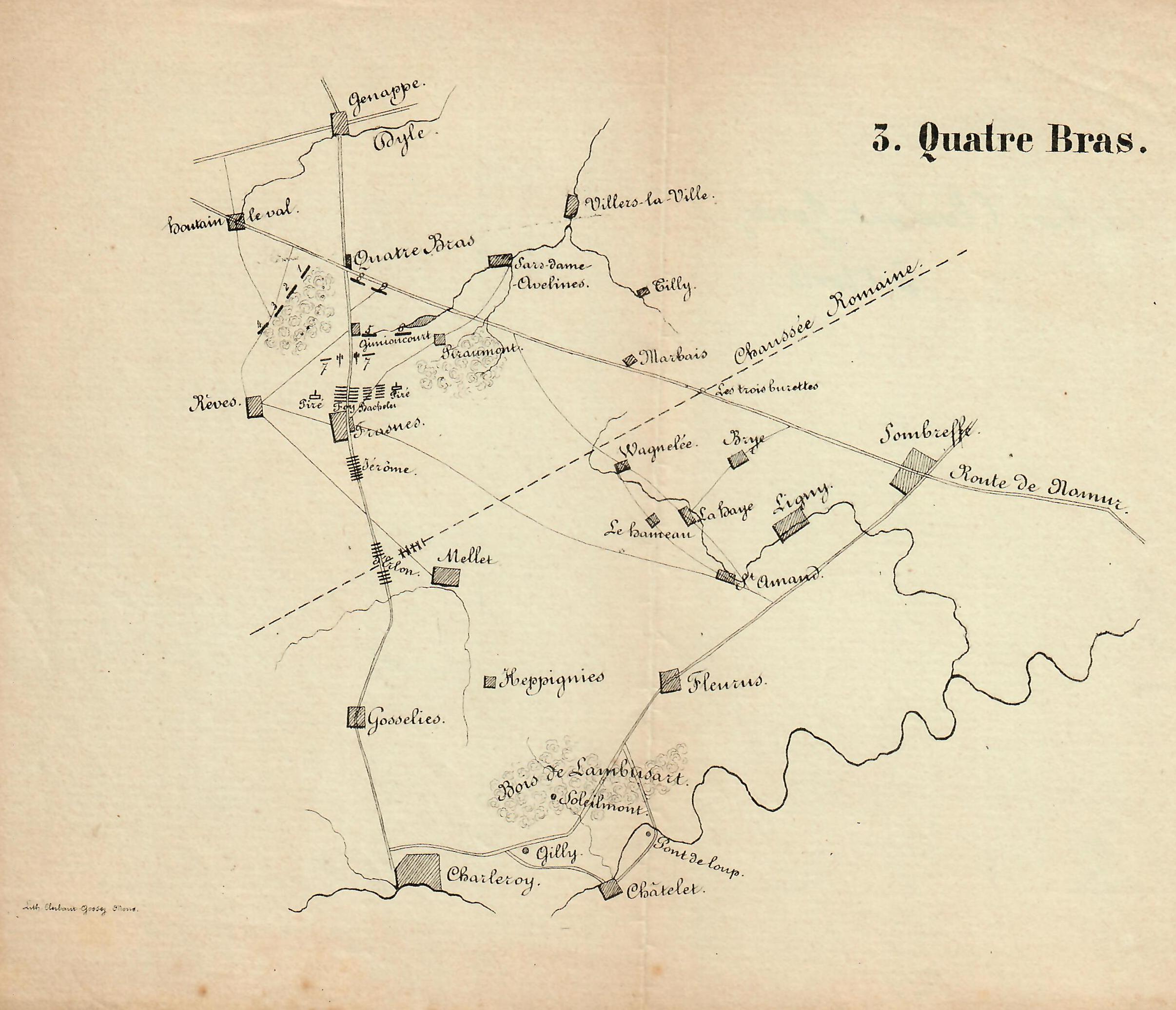
June 16 - Destroy the Prussians!
Over the course of a few hours, Napoleon realized the situation was nothing like he believed. Prior to leaving for Fleurus, Napoleon was informed that Anglo-Dutch forces were present at Quatre-Bras:
Monsieur le Maréchal,
Un officier de lanciers vient de dire à l’empereur que l’ennemi présentait des masses du côté des 4- Bras ; réunissez les corps des comtes Reille et d’Erlon, et celui du comte de Valmy qui se met à l’instant en route pour vous rejoindre ; avec ces forces, vous devrez battre et détruire tous les corps ennemis qui peuvent se présenter. Blücher était hier à Namur, et il n’cst pas vraisemblable qu’il ait porté des troupes vers les 4-Bras; ainsi, vous n’avez affaire qu’à ce qui vient de Bruxelles.
Le maréchal Grouchy va faire le mouvement sur Sombref, que je vous ai annoncé et l’Empereur va se rendre à Fleurus ; c’est là où vous adresserez vos nouveaux rapports à Sa Majesté.Le maréchal d’empire
Major Général
duc de dalmatieArchives Nationales, Pierrefitte-sur-Seine, Papiers du maréchal Ney, 137 AP/18
Translated:
Marshal, an officer of Lancers has just told the Emperor that the enemy is present in mass at Quatre Bras; assemble the Corps of Counts Reille and d’Erlon and that of Count of Valmy who is at this moment en route to join you; with these forces you must attack and destroy all the enemy corps that present themselves; Blücher was in Namur yesterday and it is not credible that he moved troops towards Quatre Bras, thus you are opposed by only what comes from Brussels.
Marshal Grouchy will execute the movement on Sombreffe that I announced to you, and the Emperor will go to Fleurus; it is there that you will address your new reports to his majesty.
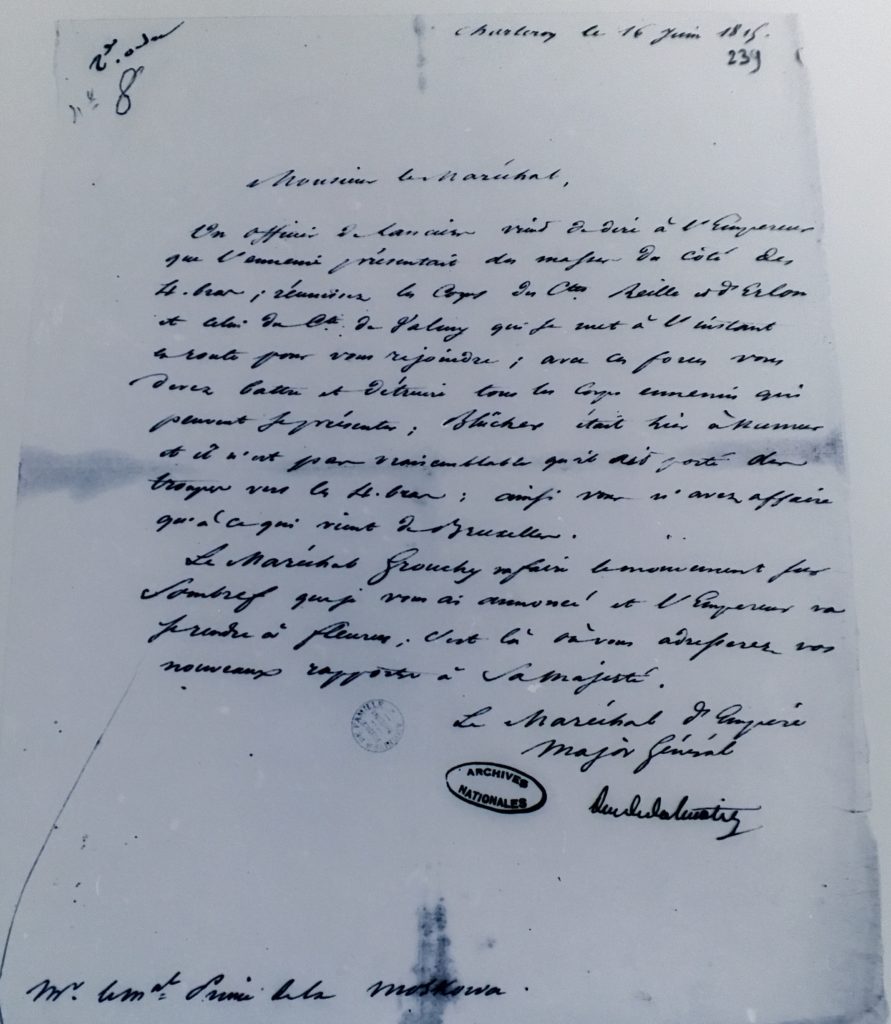
While Napoleon and Soult were alarmed at the presence of troops in Quatre-Bras, Ney was writing to Napoleon, at 11am, a letter that Napoleon would receive after he arrived in Fleurus:
Frasne, le 16 juin à 11 heures du matin.
À Son Excellence le Maréchal Duc de Dalmatie, Major Général.
Je reçois à l’instant vos instructions sur le mouvement des 1er et 2e corps d’infanterie;
de la division de cavalerie légère du Général Piré et des 2 divisions de cavalerie du 3e corps.
Celles de l’Empereur m’étaient déjà parvenues.
Voici les dispositions que je viens d’expédier.
Le 2e corps, Général Reille, aura une division en arrière de Genappe, une autre à Banterlet, les 2 autres à l’embranchement des quatre-Bras.
Une division de cavalerie légère du Général Piré ouvrira la marche du 2e corps.
Le 1er corps s’établira savoir : une division à Marbais, les 2 autres à Frasne, une division de cavalerie légère à Marbais, les 2 divisions du Comte de Valmy à Frasne et Liberchies.
Les 2 divisions de cavalerie légère de la Garde resteront à Frasne où j’établis mon Quartier Général.
Tous les renseignements portent qu’il y a environ 3000 hommes d’infanterie ennemie aux quatre Bras et fort peu de cavalerie. Je pense que les dispositions de l’Empereur pour la marche ultérieure sur Bruxelles s’exécuteront sans grands obstacles.
Le Maréchal Prince de le Moskova.
(Signé) NeÿCertifié conforme à l’original communiqué par Mr. Charavay le 20 février 1890
le Lt Colonel
Chef de la Section historique.
E. HendersonService Historique de la Défense, Armée du Nord – 11 au 21 juin – 1815, GR 15 C 5
Translated:
I receive at this moment your instructions for the movement of the 1st and 2nd Infantry Corps, and for General Piré’s Light
Cavalry Division and the two Cavalry Divisions of the 3rd Corps.
Those of the Emperor have already reached me. Here are the placements that I have just ordered:
The 2nd Corps, General Reille, will have a division behind Genappe, another at Bauterlet, and the two others at Quatre Bras.
A Light Cavalry division of General Piré will cover the 2nd Corps’ march.
The 1st Corps will set up as follows: a division at Marbais, two others in Frasne, a Light Cavalry Division at Marbais, two divisions of Comte de Valmy at Frasne and Liberchies.
The two Divisions of Light Cavalry of the Guard will remain in Frasne where I establish my headquarters.
All of the information reveals that there are about 3000 enemy infantrymen at Quatre Bras and very few cavalry. I think that the arrangements of the Emperor for the subsequent march on Brussels will be carried out without great obstacles.
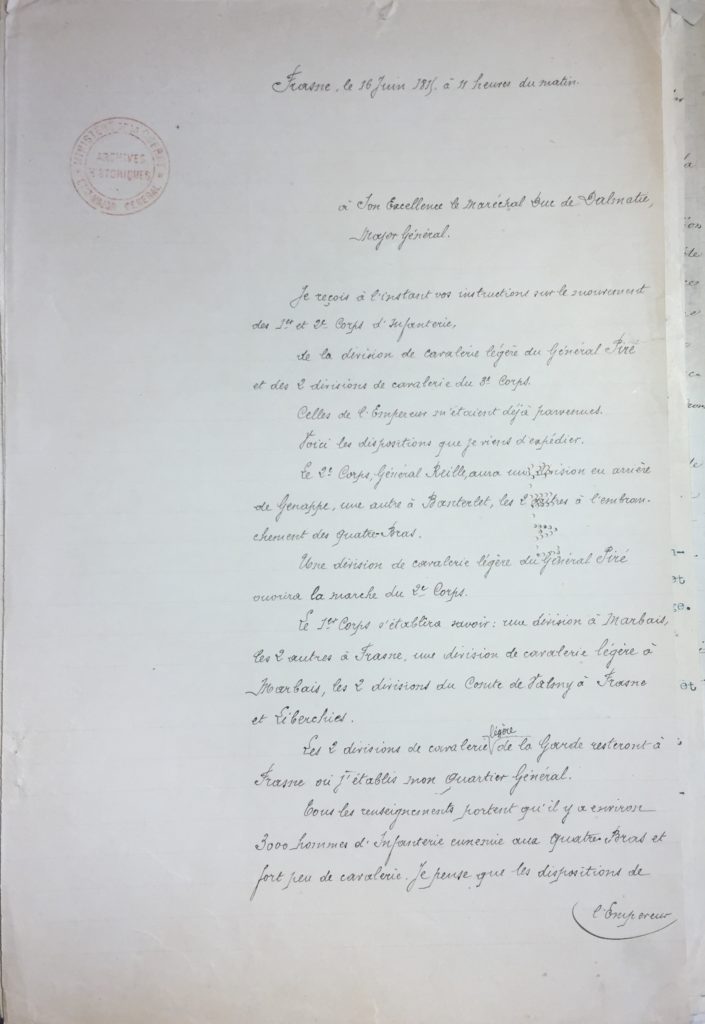
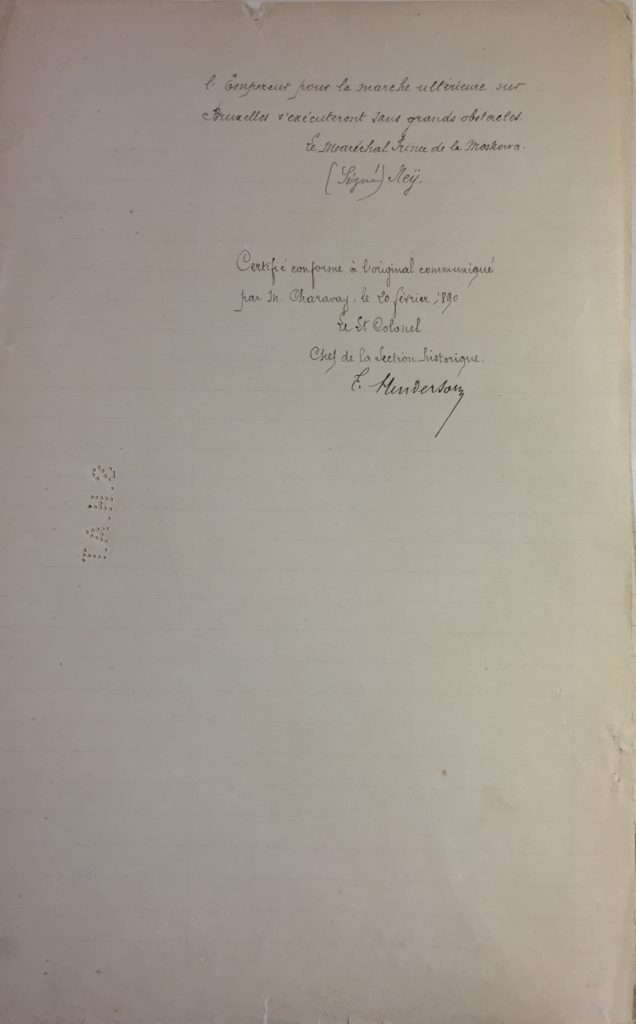
Reading Ney’s report, there was every indication that Ney had operational control of the entirety of the left wing. d’Erlon was at Gosselies when Napoleon would receive this report in the early afternoon at Fleurus. 1st Corps was delayed by the tail end of 2nd Corps that was only then just moving towards Quatre Bras.
During the early afternoon, Napoleon adjusted his plans. Instead of a march to Brussels, he would destroy the Prussian force in his front.
Napoleon’s plan was to pin the Prussian body, and order Ney to send a portion of his wing into the right rear of the Prussian position.
At 2pm, Soult wrote two letters to Ney:
En avant de Fleurus le 16 juin
à 2 heuresMonsieur le Maréchal, l’Empereur me charge de vous prévenir que l’ennemi a réuni un corps de troupes entre Sombref et Bry, et qu’à deux heures et demie M. le maréchal Grouchy, avec les troisième et quatrième corps, l’attaquera ; l’intention de Sa Majesté est que vous attaquiez aussi ce qui est devant vous, et qu’apres l’avoir vigoureusement poussé, vous rabattiez sur nous pour concourir a envelopper le corps dont je viens de vous parler. Si ce corps était enfoncé auparavant, alors S. M. ferait manoeuvrer dans votre direction pour hâter également vos opérations.
Instruisez de suite l’Empereur de vos dispositions et de ce qui se passe sur votre front.Le Maréchal d’Empire Major Général
duc de dalmatieArchives Nationales, Pierrefitte-sur-Seine, Papiers du maréchal Ney, 137 AP/18
Translated:
Marshal, the Emperor desires me to inform you that the enemy has assembled a body of troops between Sombreffe and Bry, and at 2:30 pm Marshal Grouchy will attack the enemy position with the 3rd and 4th Corps. The intention of His Majesty is that you attack what is before you, and that after having vigorously pressed them, you will turn back on us so as to envelop the enemy corps that I just mentioned. If this corps is overthrown first, then His Majesty will maneuver in your direction, to hasten your operations as well.
Inform the Emperor of your dispositions and what occurs on your front.
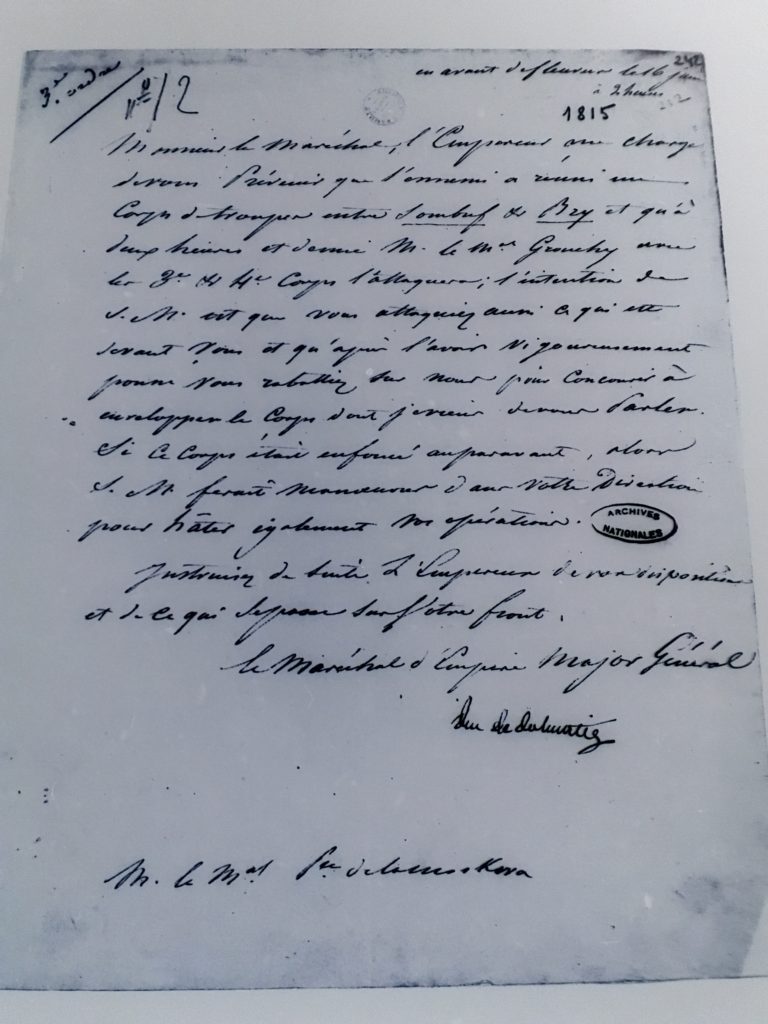
About this time, Napoleon deployed his army for the battle, this map from Stoffel’s notes:
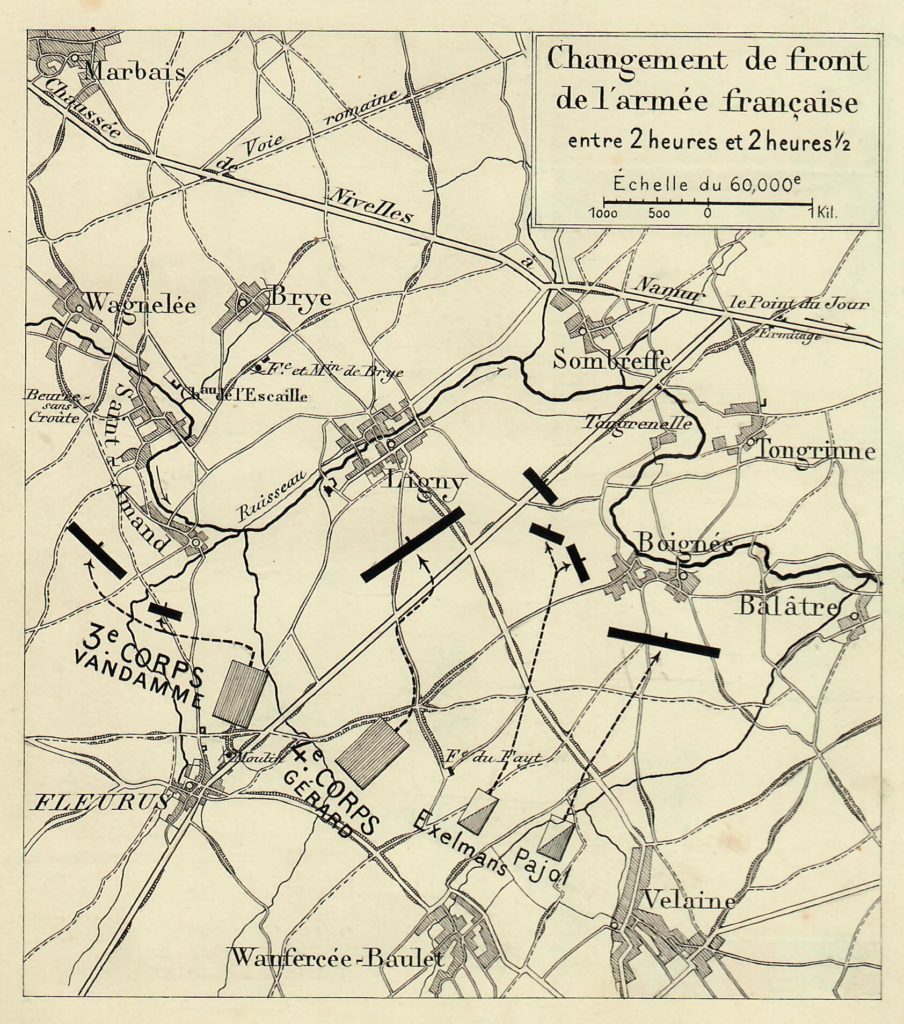
From Napoleon’s Memoirs:
At three o’clock in the afternoon, the 3rd Corps assaulted the village of Saint-Amand. A quarter of an hour later, the 4th Corps assaulted the village of Ligny, and Marshal Grouchy bent back the left of the Prussian Army. All the positions and houses situated on the right of the ravine were taken, and the enemy army thrown back on to the left bank.
At 3:15 and 3:30, with the battle heavily engaged and going as planned, Napoleon had Soult send another order to Ney:
3:15pm
Monsieur le Maréchal, je tous ai écrit, il y a une heure, que l’empereur ferait attaquer l’ennemi à 2h 1/2 dans la position qu’il a prise entre les villages de St Amand et de Bry; en ce moment l’engagement est très prononcé ; Sa Majesté me charge de tous dire que tous devez manoeuver sur-le-champ de manière à envelopper la droite de l’ennemi et tomber à bras raccourcis sur ses derrières ; cette armée est perdue si tous agissez vigoureusement ; le sort de la France est entre vos mains. Ainsi n’hésitez pas un instant pour faire le mouvement que l’empereur vous ordonne, et dirigez-vous sur les hauteurs de Bry et de St Amand, pour concourir à une victoire peut-être décisive. L’ennemi est pris en flagrant délit au moment où il cherche à se réunir aux Anglais.
Le Major Général
duc de dalmatieArchives Nationales, Pierrefitte-sur-Seine, Papiers du maréchal Ney, 137 AP/18
Translated:
Marshal, I wrote to you, an hour ago, that the Emperor would attack the enemy at 2:30 pm, in the position that it took between the village of St. Amand and Bry, at this moment the action is in full swing. H.M. charged me to say to you that you must maneuver immediately, so as to envelop the enemy line and strike his rear. This army is lost if you act aggressively. The fate of France is in your hands; thus do not hesitate a moment to carry out the movement that the Emperor orders and is aimed at the heights of St. Amand and Bry to contribute to a possible decisive victory, the enemy has been caught in the act, at the moment when they look to join the English.
The “body of troops” is now an Army, and Napoleon recognizes the strategic value of its destruction. He famously includes, “The fate of France is in your hands.”
At this same time, Napoleon received a report from Lobau that suggested not more than 20,000 of the enemy were at Quatre Bras, but there had been reports of Wellington marching from Mons to Charleroi:
Rapport à S.M. L’Empereur
Sire,
En conformité des ordres de Votre Majesté, j’ai envoyé L’adjudant Commandant Jeanin au corps commandé par Mr le Maréchal Prince de la Moscowa. Cet officier a trouvé ces troupes échelonnées depuis les environs de Gosselie jusqu’au delà de frasne ; il a beaucoup d’habitude de la guerre et croit que l’ennemi n’est pas en très grande force; mais il est difficile, en raison des forêts, de juger avec précision. Le colonel précité a causé avec plusieurs officiers supérieurs, il a aussi interrogé des déserteurs, et aucun des individus questionnés n’a porté le nombre de l’ennemi au-delà de vingt mille hommes; quand cet officier a quitté Le terrain, il n’y avait que des tirailleurs engagés, même en assez petit nombre.
Je suis toujours en position en avant de Charleroi où je resterai jusqu’à nouvel ordre. il seroit bon que Votre Majesté voulut bien faire remplacer Le bataillon que j’ai en ville pour La police et pour un assez grand nombre de Bagages ; protéger les blessés &cta. ; ce point ne pouvant, ce me semble, rester totalement dégarni de troupes.
Le Lieutt Gal aide de Camp de l’empereur
Commandant en chef le 6e Corps
Cte N Lobaup.s. Le Colonel jeanin rapporte que le Colonel Tancarville, chef d’état major du Cte de Valmy, lui a dit que les émissaires venus au Cte d’Erlon Lui avoient déclaré que l’ennemi devoit aujourd’hui marcher de Mons sur charleroi. Votre majesté sera surement à porter d’apprécier cet avis.
Service Historique de la Défense, Armée du Nord – 11 au 21 juin – 1815, GR 15 C 5
Translated:
In accordance with Your Majesty’s orders, I sent Adjudant-Commandant Jeanin to the corps commanded by Marshal Ney. This officer found these troops positioned from the surroundings
of Gosselies to beyond the village of Frasnes. He has a lot of experience in war and thinks that the enemy is not in very great force; but it is difficult, because of the forests, to judge precisely.
The previously mentioned Colonel talked with several superior officers, and he finally interrogated deserters, and none of the individuals questioned brought the number of the enemy beyond 20,000 men; when this officer left the site, there were only skirmishers engaged, these in a rather small number.I am still positioned in front of Charleroi where I will remain until given new orders. It would be good if Your Majesty wanted to replace the battalion that I have in town for police and the large numbers of baggage; to protect the wounded etc; this position cannot, it seems to me, remain completely devoid of troops.
Charleroi, June 16, 1815
Lieutenant General, Aide-de-Camp of the Emperor, Commander
in Chief of the 6th Corps
LobauP.S. Colonel Jeanin reports that Colonel Tancarville, Chief of Staff of Cte of Valmy, said to him that the emissaries who came to Cte D’Erlon reportedly said to him that the enemy was marching today from Mons to Charleroi. Your Majesty will surely be able to fully appreciate the value of this information.
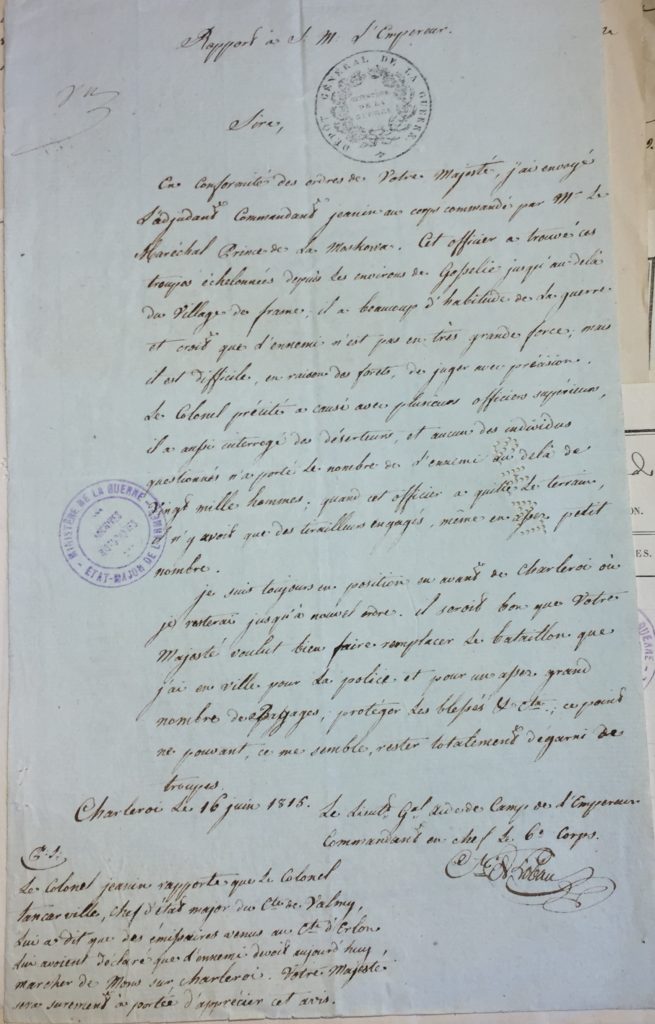
The report of Wellington advancing from Mons was probably the source of a reconnaissance d’Erlon performed from Gosselies, furthering delaying his march. As a result, d’Erlon was still at Gosselies at 3pm. While Napoleon was sending orders to Ney to envelop the Prussians at Ligny, half of Ney’s force was closer to Napoleon than Ney.
Napoleon’s account of the battle continues:
The village of Ligny was taken and retaken four times, Count Gérard covered himself with glory there and displayed as much bravery as talent. The attack was weak at the village of Saint-Amand, which was also taken and retaken; but it was carried by General Girard, who, having received the order to advance by the left of the ravine with his division, the 3rd of the 2nd Corps, brought into play there that intrepidity of which he had shown so many examples during his military career. He overthrew at the point of the bayonet all who thought to oppose his advance, and took possession of half the village; but he fell, fatally wounded.
Around 5:30pm, a body of troops was spotted marching towards the French rear from the west. These could not be troops from Ney, as they would be marching to the rear of the Prussian right.
From the onset of the advance, the French had been concerned about the left. d’Erlon had been repeatedly ordered to patrol towards Mons. He had continued this mission during his march to Frasne. While Houssaye claims Soult received d’Erlon’s report from Gosselie and found it in Gourgaud’s papers, it is not there now. Much that was once reference in the French archives has gone missing, and many items found in Auctions often have the pinholes and stamps of the Archives.
The sight of these unknown soldiers concerned the French command and troops alike. The battle was delayed an hour while they were identified. By then, the majority simply marched away. Napoleon thought this “inexplicable”, and returned to the action at hand.
The reason this force was so disruptive is clear. An allied thrust from Mons had been a risk of the campaign. Napoleon probably discussed it with the various Corps commanders on June 13 and June 14, and the entire French army was aware of the threat – one only need look at a map. Napoleon did not expect the allies to be concentrated on June 16, yet faced a Prussian army at Ligny. It was certainly possible Wellington could have concentrated at Mons.
With the crisis averted, Napoleon finished the battle, from his Memoirs:
The Guard thereupon resumed its march on Ligny. General Pecheux, at the head of his division, crossed the ravine; Count Gérard, the whole of the Guard, infantry, cavalry, artillery and cuirassiers, and Milhaud’s division supported his movement. All the enemy reserves were overwhelmed at the point of the bayonet; the centre of his line was pierced.
The battle was won, but too late for an effective pursuit. Night fell, and most French units bivouacked on the battlefield. The Prussians established a reasonable rear-guard, and then began their retreat. At a council of war after the battle – and with some consideration of retreating east to await the Austrians and Russians – it was decided instead to retreat to Wavre in the north, thus to remain in cooperation with Wellington, who later called the decision to retreat on Wavre the “decisive moment of the century.”
The time lost due to d’Erlon’s unexpected appearance at the rear of the French lines prevented Napoleon from dictating his terms on the victory. The cavalry he had massed, along with the Imperial Guard, could have easily followed up the breaking of the Prussian center with scattering the Prussian right and seizing the key northern points in the rear of the Prussian
lines that would have compelled a retreat to the east.
